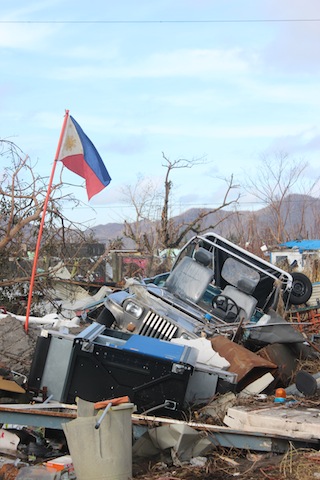TACLOBAN CITY— Unimaginable destruction. Heartbreaking situation of tormented survivors. Signs of mortal decay on main roads. No enough food, clean water, medicine and shelter. Toppled and cut-off power and communication lines. This is the situation in Tacloban City, the ground zero of Super Typhoon Yolanda (international name: Haiyan)
Haiyan, the strongest ever typhoon that made landfall, has flattened Tacloban City and left other eight regions in the Philippines in vast destruction.
According to the National Disaster Risk Reduction and Disaster Management Council (NDRRMC), at least 11 million are estimated to be affected in the area, with 2,500 deaths reported by the Philippine . The death toll is feared to rise in the coming days. The typhoon has displaced over 74,000 families in 43 provinces.
Structures of the former departure and baggage claim areas at the Tagbilaran airport are hardly recognizable, with the GI sheet roofs completely ripped off the buildings, concrete walls turned into rubbles, shards of glass lying on the ground together with steel frames and power cables. Fallen trees lie side by side with overturned vehicles everywhere.
Despite the massive damage, the airport seems to be the most functional part of the province. It serves as the hub for receiving relief aid and as command post for the military, health workers, and social workers distributing relief into the affected areas.
Today, the former airport or what was left of its structure serves as a refuge for most typhoon survivors, who had to endure walking kilometers for several days, as it will get them a higher chance to scramble for water and food carried alongside luggages and other relief aid dispatched from the planes.
Every day, people troop to the airport in an attempt to get a number and ride in one of four C130 planes of the Philippine Air Force and US Navy. There are at least six to ten flights that bring survivors to Manila and Cebu province, the northern tip of which was also along the path of Haiyan. They say, a glimpse of the C130 planes remind the survivors of a chance out of the misery they have been in for almost a week.
Aid has been pouring in to the Philippines, but distribution has been criticized by international and local sectors for its slow dispatch.
The Philippine government has assigned Manila, Cebu, and Tacloban as the three distribution hubs for receiving international aid but repacking and distribution of the relief to those in the affected areas are slowed down due to the lack of distribution vehicles.
As communication lines started to be restored in some of the affected areas and some people were able to travel to Manila from other places such as Samar, they plea for help for the areas where they come from such as Guiuan in Samar, Palo in Leyte, Bantayan Island in Cebu and Capiz, among others.
Traumatized Maria Rose Tumulak, mother of five, recalled that as the water started to rise above her head, she immediately swam for a floating laundry tub and placed her five young kids in order to save them. They survived.
“We survived the typhoon but it seems, we are still not safe. Survival after the typhoon seems a bigger challenge to us now and we try to hang on, waiting for relief aid to come to our part here,” says Tumulak.
For millions of people who survived the wrath of Super Typhoon Haiyan, all what they ask now is “Where do we begin?”
Text and photo by Anna Valmero, reporting from Tacloban City
Anna Valmero
Latest posts by Anna Valmero (see all)
- Thousands took to the streets of Paris for climate action - December 13, 2015
- Rallies call for climate change action - December 12, 2015
- Climate-induced migration must be at the core of the Paris deal - December 11, 2015

